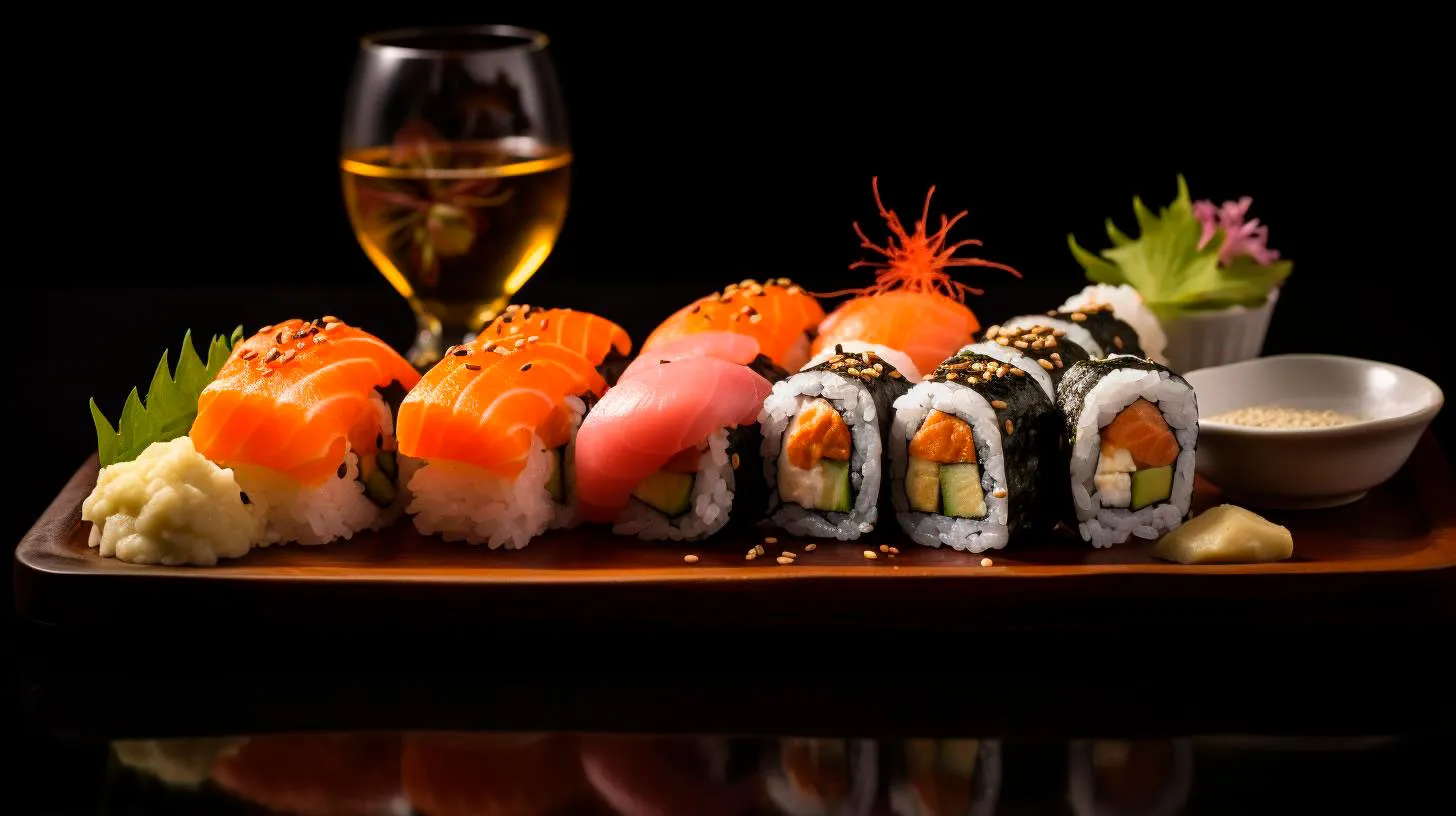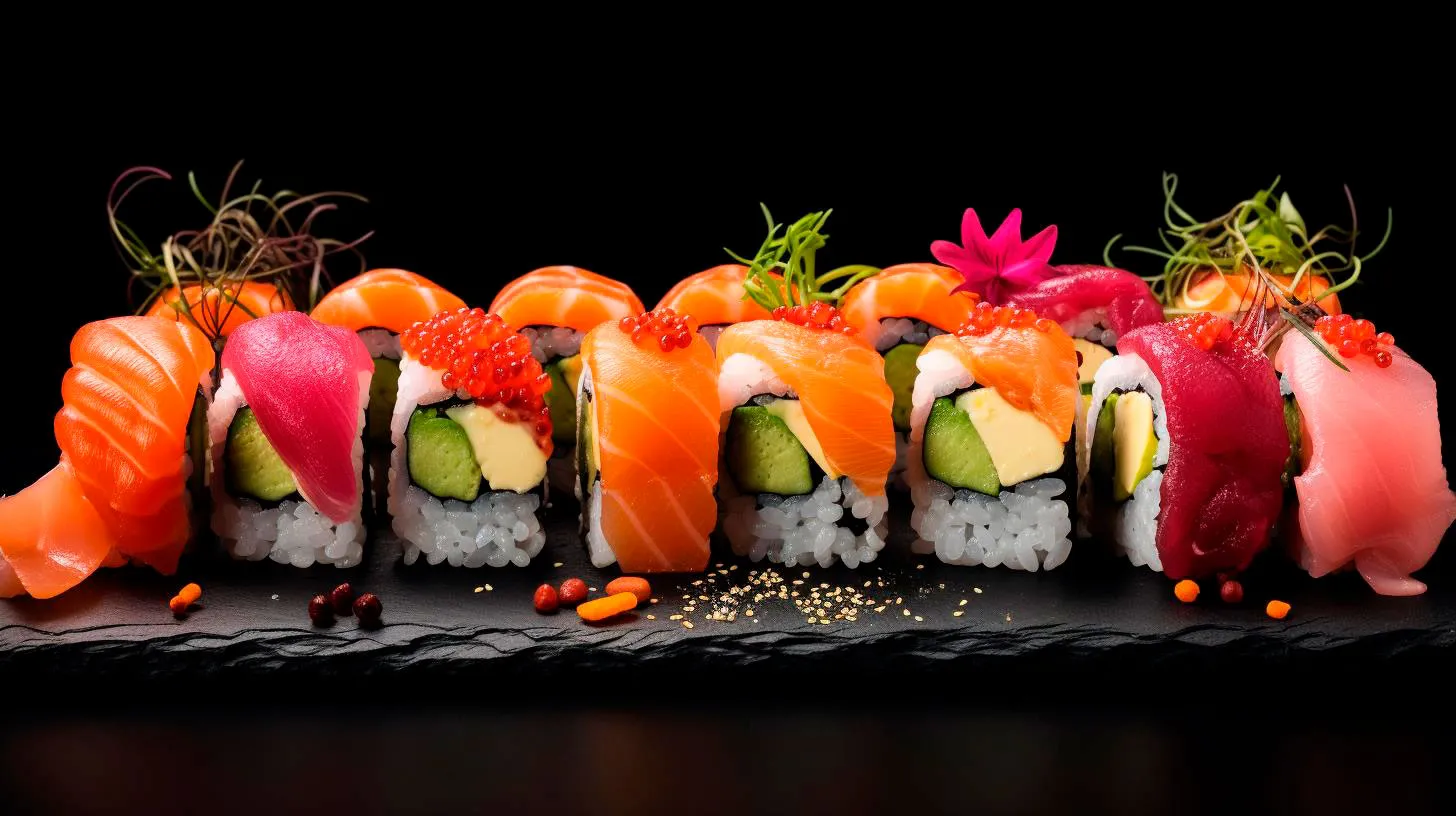Harmony on a Plate: Balancing Flavors in Every Sushi Creation
It requires a deep understanding of the ingredients, techniques, and the art of balancing flavors. In this article, we will explore the importance of harmony in sushi and how it contributes to an exceptional culinary experience.
The Essence of Sushi
Sushi originated in Japan and has been around for centuries. It is a cultural icon that represents Japan’s precision, craftsmanship, and respect for ingredients. At its core, sushi is a combination of vinegared rice known as “shari” and various toppings such as fish, vegetables, or other seafood delicacies. The art lies in the delicate balance of flavors within each sushi roll or nigiri.
The Key Elements of Flavor Balancing
1. Umami – Known as the fifth taste, umami is essential in sushi. It is a savory flavor that enriches the overall experience. The use of ingredients like soy sauce, miso, and certain types of fish enhances umami, adding depth to the flavors.
2. Freshness – Freshness is of utmost importance in sushi. The fish should be high-quality and sourced from trusted suppliers. Focusing on locally sourced ingredients can ensure the freshest flavors and support sustainable practices in the industry.
3. Textures – Sushi is not only about taste but also about texture. The combination of soft, tender fish with crunchy vegetables or creamy avocado creates a delightful sensory experience.
4. Color Palette – A visually appealing sushi plate is as important as its flavors. A harmonious color palette, comprising different shades of fish, vegetables, and garnishes, enhances the overall aesthetic appeal.
The Role of Ingredients
Each ingredient in sushi plays a significant role in achieving the perfect balance of flavors. Here are a few key ingredients and their contributions:
- Shari (Sushi Rice): The foundation of sushi, properly seasoned sushi rice binds the flavors together and complements the other ingredients.
- Nori (Seaweed): Nori adds a hint of saltiness and a unique umami flavor. It also provides a textural contrast to the sushi roll.
- Wasabi: This fiery green paste, made from Japanese horseradish, adds a pungent kick to the sushi. It complements the flavors and clears the palate.
- Soy Sauce: The umami-rich soy sauce balances the flavors and adds a touch of saltiness. It is often used as a dipping sauce for sushi.
- Sashimi-Grade Fish: Freshness and high-quality fish are the pillars of sushi. Varieties such as tuna, salmon, and yellowtail bring unique flavors and textures.
- Vegetables: Cucumber, avocado, carrot, and radish are common vegetable choices in sushi. They add refreshing flavors and provide a pleasant crunch.
The Art of Sushi Making
Sushi making is a meticulous process that requires attention to detail. Skilled sushi chefs spend years honing their craft to ensure each bite is a symphony of flavors. Here are a few techniques involved in achieving flavor harmony:
- Proportional Ingredient Placement: Sushi is a delicate balance of flavors, so proper placement of ingredients is crucial. Chefs strategically arrange ingredients to achieve a harmonious taste profile.
- Minimalism: Less is often more in sushi. Keeping the flavors balanced and not overpowering any single ingredient allows for a subtle and elegant taste.
- Precision in Cutting: The way the fish and vegetables are sliced greatly affects the overall enjoyment of sushi. Chefs masterfully slice the ingredients to ensure an optimal texture and mouthfeel in every bite.
- Temperature Considerations: The temperature of ingredients also influences flavor balance. For example, warm rice with cool fish creates a harmonious contrast.
- Presentation: The visual presentation of sushi is essential. Chefs use garnishes, edible flowers, and creative plating techniques to enhance the overall dining experience.
Conclusion: Savor the Harmony
By understanding the importance of balance and harmony, you can truly appreciate the artistry behind each sushi creation. The marriage of flavors, textures, and visual aesthetics make sushi not only a culinary delight but also an experience for all the senses. So, the next time you indulge in a piece of sushi, take a moment to savor the symphony of perfectly balanced flavors on your plate.
The Art of Precision Mastering the Knife for Sushi Perfection
In this article, we will explore the importance of a sushi knife, its design, and some key tips for mastering the art of precision in sushi making.
The Importance of a Sushi Knife
A sushi knife, also known as a yanagiba, is a traditional Japanese knife specifically crafted for slicing raw fish. This knife is characterized by its long, slender blade and single-edged design. The unique shape and sharpness of the sushi knife allow chefs to make precise, clean cuts that preserve the integrity of the fish and enhance the overall presentation of the sushi roll.
Let’s take a closer look at the key features and advantages of a sushi knife:
- Long Blade: The long blade of a sushi knife allows for smooth slicing motions, ensuring clean cuts with minimal effort.
- Single-Edged Design: Unlike Western-style knives, sushi knives have a single-edged design, which maximizes sharpness and precision.
- Sharpness: Sushi knives are renowned for their exceptional sharpness, allowing chefs to slice through fish with minimal effort and without damaging the delicate flesh.
- Thin Blade: The thin blade of a sushi knife reduces resistance, making it easier to cut through raw fish without tearing or crushing it.
The Mastery of Precision
Mastering the art of precision in sushi making requires dedication, practice, and the right tools. Here are some essential tips to elevate your sushi knife skills:
1. Choose the Right Knife:
Investing in a high-quality sushi knife is essential for achieving precision in your cuts. Look for a knife made from high-carbon stainless steel for optimal sharpness, edge retention, and durability. Additionally, ensure that the knife is well-balanced and comfortable to hold.
2. Honing and Sharpening:
A sharp knife is crucial for precision. Regularly hone your sushi knife using a honing rod to maintain its sharpness. When necessary, sharpen the knife using whetstones or professional sharpening services. A sharp blade ensures cleaner cuts and reduces the risk of accidents.
3. Proper Grip and Technique:
Hold the sushi knife with a pinch grip, using your thumb and index finger to control the blade. This grip provides better control and allows for precise slicing. Practice proper technique, employing smooth and controlled motions while cutting through the fish.
4. Angling Your Cuts:
When cutting fish for sushi, angle the knife slightly towards the fish to create diagonal cuts. This technique helps to maximize the surface area and enhances the visual appeal of the sushi rolls.
5. Consistency is Key:
To achieve consistently even slices, maintain a consistent cutting speed and pressure throughout. This will prevent variations in thickness and ensure a visually pleasing presentation.
6. Knife Maintenance:
Proper maintenance of your sushi knife is essential for long-lasting performance. Clean the knife by hand immediately after each use, using mild soap and warm water. Avoid abrasive materials that could damage the blade. After washing, dry the knife thoroughly and store it in a protective sheath or on a magnetic strip to prevent dulling.
Follow these expert tips and practice regularly to improve your sushi knife skills and achieve precision in every slice.
Key Takeaways
Mastering the knife for sushi making is an essential part of achieving sushi perfection. Here are the key takeaways from this article:
- Precision in sushi making requires the mastery of a sushi knife.
- A sushi knife’s long blade, single-edged design, sharpness, and thinness contribute to its advantages.
- Choosing the right knife, honing and sharpening regularly, and mastering proper grip and technique are crucial for precision.
- Angling cuts, maintaining consistency, and proper knife maintenance are additional key factors to consider.
With patience, dedication, and the right tools, you too can embark on the journey of mastering the art of precision in sushi making, creating visually stunning and delectable sushi rolls.
Mindful Mastery: The Connection between Sushi Chefs and Tranquility in Their Craft
This article explores the connection between sushi chefs and the state of mindfulness they achieve, and how it contributes to the excellence of their creations.
Mindfulness in Sushi Preparation
The art of sushi requires utmost attention to detail. From the selection of ingredients to the precise cuts, sushi chefs engage in a mindful practice that demands complete concentration. Here are a few key aspects of mindfulness in sushi preparation:
- Ingredient Selection: Sushi chefs meticulously choose the freshest and highest quality ingredients, ensuring that each piece is a gastronomic delight. The focus on sourcing premium ingredients allows them to create flavors that are unparalleled in their sophistication.
- Knife Skills: The mastery of knife skills is crucial for sushi chefs. With swift, precise movements, they transform raw fish and vegetables into delicate slices that are both visually appealing and tender. This level of precision requires a deep level of concentration and steady hands.
- Balance and Presentation: Sushi is not only about taste, but also about presentation. Sushi chefs craft each piece with artistry, considering color, balance, and texture. Each bite-sized creation reflects the chef’s attention to detail, resulting in a visually stunning presentation.
The Role of Tranquility in Sushi Craft
Tranquility plays a pivotal role in the art of sushi. Sushi chefs cultivate an environment of calmness and serenity, reflecting their focus on the present moment and the craft itself. Here are the key reasons why tranquility is intertwined with sushi mastery:
- Spiritual Connection: Sushi chefs view their work as a reflection of their inner selves. The process of preparing sushi becomes a spiritual practice, allowing them to find tranquility and inner peace through their craft. This spiritual connection enhances their ability to create harmonious flavors.
- Ritualistic Approach: Sushi preparation is steeped in centuries-old traditions and rituals. From the way chefs don their traditional attire to the precise arrangement of ingredients, each step is carried out with intention and reverence. This adherence to ritualistic practices fosters a sense of tranquility and mindfulness.
- Flow State: In the pursuit of mastery, sushi chefs enter a state of flow. This state of complete absorption in the present moment allows creativity to flourish, enabling chefs to experiment with flavors and enhance their culinary skills. The flow state promotes tranquility and a deep connection to the craft.
The Benefits of Mindful Sushi Preparation
Beyond the impeccable taste and presentation, the practice of mindfulness in sushi preparation offers several benefits that extend beyond the plate. Here are the key takeaways from the mindful mastery of sushi chefs:
- Enhanced Focus: The practice of mindfulness sharpens one’s focus and concentration. Sushi chefs, who have honed this skill, can apply it to other aspects of life, enabling them to excel in various endeavors.
- Reduced Stress: The state of tranquility achieved through sushi preparation has a profound effect on a chef’s well-being. By being fully present in the task at hand, stress and anxiety give way to a sense of calmness and contentment.
- Greater Creativity: Mindfulness allows sushi chefs to explore flavor combinations and techniques that push the boundaries of traditional sushi. This creativity brings innovation to the craft, elevating the dining experience for sushi enthusiasts.
In conclusion, sushi chefs embody the principles of mindfulness and tranquility in their craft. Through their precise techniques, attention to detail, and immersion in the present moment, they create masterpieces that not only tantalize the taste buds but also evoke a sense of inner peace. So, the next time you savor a piece of sushi, take a moment to appreciate the mindful mastery that went into its creation.
From Ocean to Table: Understanding the Essence of Freshness in Sushi
In this article, we will dive into the importance of freshness in sushi, exploring how it affects taste, quality, and even health.
The Significance of Freshness
Freshness is the cornerstone of exceptional sushi. The main ingredients, such as fish, rice, and vegetables, must be of the highest quality to create a memorable dining experience. Here’s why freshness matters:
- Enhanced Flavor: Fresh fish and other ingredients contribute to rich, vibrant flavors that tantalize the taste buds. The natural sweetness, delicate texture, and optimal moisture content are best experienced when the ingredients are at their freshest.
- Quality Assurance: Freshness ensures that the sushi ingredients are free from spoilage, bacteria, and other contaminants. This guarantees a safe and healthy dining experience for sushi lovers.
- Art of Presentation: Fresh ingredients enable sushi chefs to create visually stunning dishes. Bright, colorful fish and crisp, vibrant vegetables elevate the overall dining experience, making sushi not only a treat for the taste buds but also for the eyes.
Factors Affecting Freshness
While freshness is crucial, several factors can impact the quality and longevity of sushi ingredients. Let’s explore some of these factors:
Source and Proximity:
The source of the ingredients plays a vital role in determining the freshness of sushi. Restaurants located near coastal areas or seafood markets have an advantage as they can directly source their ingredients from local fishermen. The closer the source, the shorter the transportation time, thereby ensuring maximum freshness.
Sustainable Fishing Practices:
Choosing sushi establishments that prioritize sustainable fishing practices is essential. Sustainable fishing helps maintain fish populations, preserving the delicate marine ecosystem. By supporting such establishments, you are not only promoting freshness but also contributing to the conservation of our oceans for future generations.
Handling and Storage:
Proper handling and storage techniques are critical in maintaining the freshness of sushi ingredients. Sushi chefs follow strict guidelines to ensure that fish is handled with care, stored at the right temperature, and used within the optimal time frame. This attention to detail guarantees the highest quality and taste in each bite.
Rice Quality:
While fish is the star of the show, the quality of rice is equally important. Sushi rice must be fresh, fluffy, and well-cooked to complement the flavors and textures of the fish. The right balance of vinegar, sugar, and salt adds an extra layer of deliciousness to the overall sushi experience.
Choose Freshness, Indulge Responsibly
When dining on sushi, keep these key takeaways in mind:
- Select restaurants that source their ingredients locally or from sustainable suppliers. This ensures freshness and supports ethical practices.
- Ask about the handling and transportation practices followed by the restaurant to ensure that the sushi arrives at your table in optimal condition.
- Pay attention to the taste, texture, and appearance of the sushi. Freshness is evident in the quality and overall experience.
- Engage with sushi chefs to learn more about the sourcing and preparation methods. This allows you to appreciate the effort and dedication that goes into creating each piece of sushi.
Sushi lovers will agree that freshness is what sets apart an average sushi meal from an extraordinary one. The commitment to sourcing and using the freshest ingredients is what makes sushi an unparalleled culinary experience. So, the next time you savor a piece of sushi, remember that it is the result of a meticulous process that starts from the ocean and ends on your plate.


